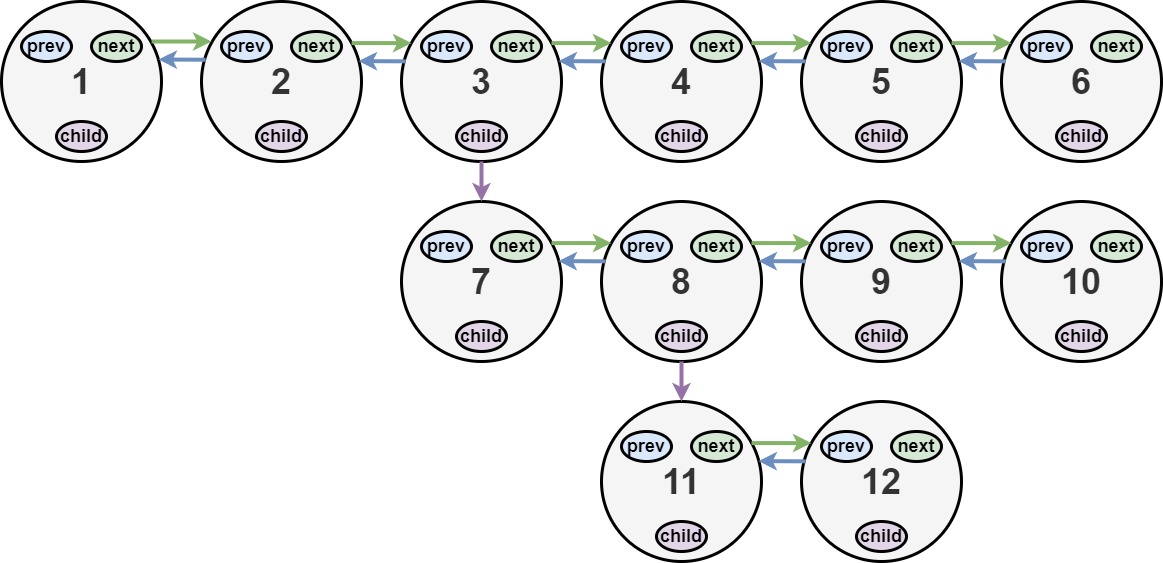Problem
You are given a doubly linked list, which contains nodes that have a next pointer, a previous pointer, and an additional child pointer. This child pointer may or may not point to a separate doubly linked list, also containing these special nodes. These child lists may have one or more children of their own, and so on, to produce a multilevel data structure as shown in the example below.
Given the head of the first level of the list, flatten the list so that all the nodes appear in a single-level, doubly linked list. Let curr be a node with a child list. The nodes in the child list should appear after curr and before curr.next in the flattened list.
Return **the *head* of the flattened list. The nodes in the list must have all of their child pointers set to **null.
Example 1:

Input: head = [1,2,3,4,5,6,null,null,null,7,8,9,10,null,null,11,12]
Output: [1,2,3,7,8,11,12,9,10,4,5,6]
Explanation: The multilevel linked list in the input is shown.
After flattening the multilevel linked list it becomes:
Example 2:
Input: head = [1,2,null,3]
Output: [1,3,2]
Explanation: The multilevel linked list in the input is shown.
After flattening the multilevel linked list it becomes:
Example 3:
Input: head = []
Output: []
Explanation: There could be empty list in the input.
Constraints:
The number of Nodes will not exceed
1000.1 <= Node.val <= 10^5
How the multilevel linked list is represented in test cases:
We use the multilevel linked list from Example 1 above:
1---2---3---4---5---6--NULL
|
7---8---9---10--NULL
|
11--12--NULL
The serialization of each level is as follows:
[1,2,3,4,5,6,null]
[7,8,9,10,null]
[11,12,null]
To serialize all levels together, we will add nulls in each level to signify no node connects to the upper node of the previous level. The serialization becomes:
[1, 2, 3, 4, 5, 6, null]
|
[null, null, 7, 8, 9, 10, null]
|
[ null, 11, 12, null]
Merging the serialization of each level and removing trailing nulls we obtain:
[1,2,3,4,5,6,null,null,null,7,8,9,10,null,null,11,12]
Solution (Java)
/*
// Definition for a Node.
class Node {
public int val;
public Node prev;
public Node next;
public Node child;
};
*/
class Solution {
// is true ONLY for the first element of the list
private boolean first = true;
// Holds the head node of the newly constructed doubly linked list
private Node root;
// Holds the current node of the newly constructed doubly linked list
private Node current;
public Node flatten(Node head) {
if (head == null) {
return root;
} else {
// Construct our doubly linked list
if (first) {
first = !first;
root = new Node(head.val);
current = root;
} else {
// Map all values to the newly constructed list.
// temp value to hold our prev element
Node temp = current;
current.next = new Node(head.val);
current = current.next;
current.prev = temp;
}
}
// iterate over child nodes.
if (head.child != null) {
flatten(head.child);
}
if (head.next != null) {
// iterate next
flatten(head.next);
}
return root;
}
}
Explain:
nope.
Complexity:
- Time complexity : O(n).
- Space complexity : O(n).
